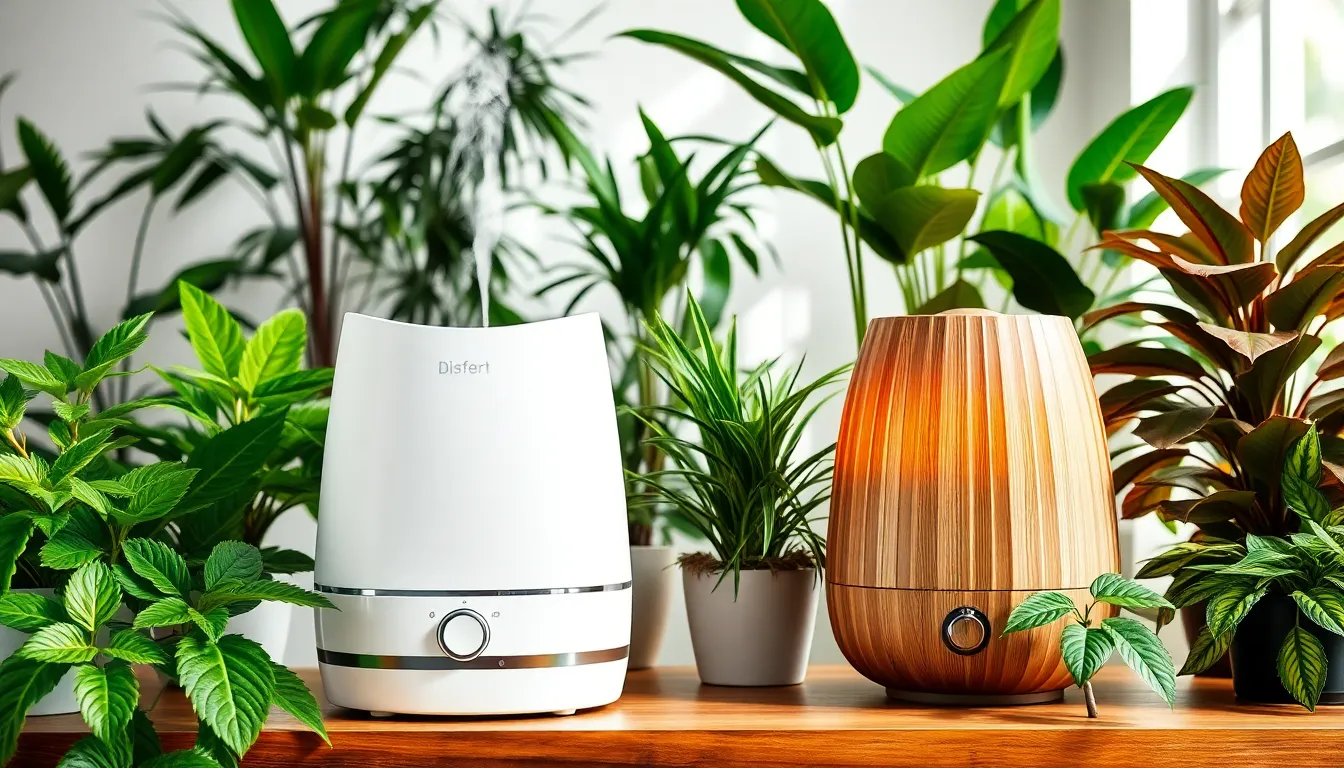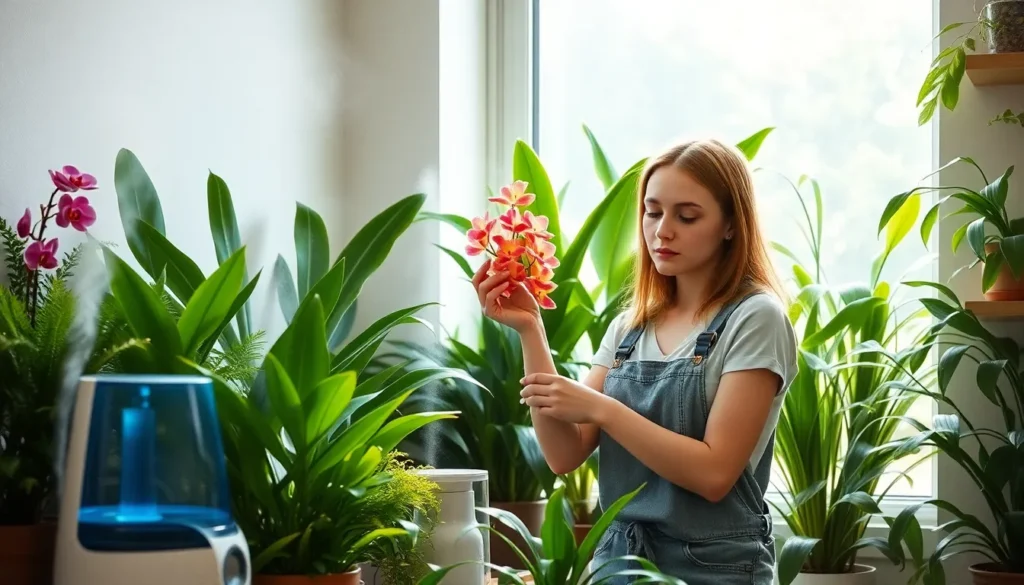Plants thrive in environments that mimic their natural habitats, and humidity plays a crucial role in their health. For indoor gardeners, maintaining the right moisture levels can be a challenge, especially in dry climates or during winter months. That’s where a humidifier for plants comes into play. This handy device can create the ideal microclimate, ensuring that plants receive the moisture they need to flourish.
Using a humidifier not only enhances plant growth but also helps prevent issues like leaf drop and brown tips. By introducing consistent humidity, indoor gardeners can create a vibrant oasis that encourages lush foliage and blooming flowers. Whether nurturing tropical plants or sensitive seedlings, a humidifier can be a game changer in any indoor gardening setup.
Table of Contents
ToggleBenefits Of Using A Humidifier For Plants
Using a humidifier benefits plants by maintaining optimal humidity levels, crucial for their overall health. Increased moisture in the air supports thriving indoor gardens, particularly in dry conditions.
Improves Plant Health
Humidity directly influences plant health by preventing stress-related issues. Plants exposed to low humidity can develop problems like leaf drop, brown tips, and stunted growth. A humidifier helps maintain humidity levels between 40-60%, ideal for many tropical and delicate species. By creating a stable environment, plants can absorb water more efficiently, enhancing nutrient uptake. Healthier plants exhibit vibrant foliage and improved resilience against pests and diseases.
Enhances Growth Rates
Increased humidity promotes faster growth rates in various plant species. Studies show that plants in adequately humidified environments often exhibit growth rates up to 25% faster than those in drier conditions. A humidifier creates a microclimate that replicates tropical conditions, crucial for seedlings and young plants. Enhanced humidity encourages root development, leading to stronger plants capable of supporting larger foliage and blooms.
Types Of Humidifiers Suitable For Plants

Several types of humidifiers effectively maintain optimal humidity levels for plant health. The most suitable options include cool mist and warm mist humidifiers, each with distinct advantages.
Cool Mist Humidifiers
Cool mist humidifiers release a fine mist of water vapor into the air, helping to increase humidity without raising the temperature. These humidifiers typically use ultrasonic technology or evaporative methods to produce moisture. They are ideal for tropical plants requiring high humidity levels, as they can maintain consistent moisture in the environment. Additionally, cool mist humidifiers operate quietly, making them suitable for indoor settings where noise may be an issue. Regular cleaning prevents the growth of mold or bacteria, ensuring a healthy atmosphere for plants.
Warm Mist Humidifiers
Warm mist humidifiers produce steam that cools slightly before entering the air. This type of humidifier can boost humidity while also raising ambient temperature, making it beneficial during cooler months. Warm mist models often include a built-in filter, which helps purify the water and improves air quality. These humidifiers are advantageous for certain plant species that thrive in warmer, more humid environments. However, they may consume more energy and require more frequent maintenance due to mineral buildup from the water used.
Choosing The Right Humidifier For Your Plants
Selecting the appropriate humidifier is essential for creating an optimal environment for plants. Various factors, including room size and plant type, dictate the most effective humidifier choice.
Room Size Considerations
Room size significantly influences humidifier selection. Assessing the square footage of the space helps determine the humidifier’s output capacity.
- Small Rooms (up to 200 sq. ft.): Personal or small ultrasonic humidifiers work well, typically producing around 0.75-1.5 liters of moisture per day.
- Medium Rooms (200-400 sq. ft.): A humidifier with a capacity of 2-4 liters daily suffices, ensuring adequate humidity without excessive moisture.
- Large Rooms (over 400 sq. ft.): Units designed for larger spaces release 4+ liters daily, covering expansive areas effectively.
Maintaining humidity levels between 40-60% is crucial, regardless of room size. Larger spaces may require multiple units or strategically placed humidifiers.
Plant Type Considerations
Plant types dictate humidifier requirements, as specific species thrive under varied humidity levels.
- Tropical Plants: Species like ferns and orchids benefit from higher humidity levels, ideally between 60-80%. Choose a humidifier with adjustable settings for flexibility.
- Succulents and Cacti: These plants prefer lower humidity. A cool mist humidifier with a timer can prevent excess moisture, keeping levels around 30-40%.
- Seedlings and Young Plants: These delicate plants thrive in higher humidity (around 70-80%). Opt for a warm mist humidifier, as it provides consistent moisture without risking root rot.
Identifying the plant type informs the choice of humidifier, ensuring the environment supports healthy growth and minimizes stress.
Tips For Using A Humidifier Effectively
Utilizing a humidifier correctly enhances plant health and growth. Here are essential tips for optimizing humidity levels and maintaining equipment.
Maintaining Optimal Humidity Levels
Maintaining humidity levels between 40-60% benefits most indoor plants, particularly tropical species. Monitoring humidity with a hygrometer ensures accuracy. Placing the humidifier near plants promotes even moisture distribution. Observing plant response to humidity adjustments, such as leaf health and growth rates, helps fine-tune settings. If humidity consistently falls below recommended levels, consider using multiple humidifiers for larger spaces or grouping plants together to create a microclimate.
Regular Cleaning and Maintenance
Cleaning humidifiers routinely prevents mold and bacteria growth, which can harm plants. Refill tanks with distilled or demineralized water to minimize mineral buildup, which clogs systems and affects performance. Disassemble and rinse components weekly to remove residue. Monthly deep cleaning with a vinegar solution removes scale and maintains optimal function. Check and replace filters according to manufacturer recommendations to ensure clean mist output, supporting healthier plants.
Investing in a humidifier can transform indoor gardening by creating the ideal environment for plant growth. By maintaining optimal humidity levels, it supports healthier plants and enhances their resilience against pests and diseases. Whether choosing a cool mist or warm mist humidifier, understanding the specific needs of different plants is essential for success.
With proper maintenance and monitoring, gardeners can ensure their plants thrive in a balanced microclimate. This small addition to the indoor gardening toolkit can lead to impressive growth rates and vibrant foliage, making it a worthwhile consideration for any plant enthusiast.



